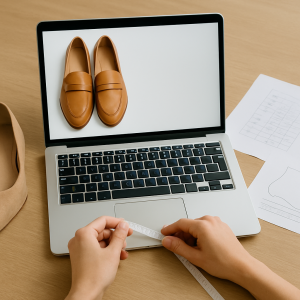Date: 22 Jul 2025
1. Measure your foot properly
Many people just guess their size – and then wonder why shoes pinch or slip. Real accuracy starts with a sheet of paper on the floor – place it so it won’t move. Stand barefoot and upright, distributing your weight evenly – feet expand when you stand. Mark the tip of your longest toe and the back of your heel. Do the same for the other foot – it’s common to find a few millimeters difference. Use a ruler or tape measure to check the distance between those points. Round to the nearest millimeter – even tiny differences matter. Measure the width of your foot too, especially if shoes often feel tight on the sides. Keep these measurements written down for future orders. Some people even make a cardboard template – a clever trick for consistency.
2. Compare with the store’s specific size chart
Each brand uses slightly different molds – size 8 in one may feel like 7.5 in another. Most online stores provide a size chart with measurements in centimeters or inches – this is your guide. Find it and match it to your numbers instead of relying on your usual size. If the brand lists widths (narrow, regular, wide) – take that into account as well. For sports shoes you may need extra space for toe movement. Check customer comments – many people share real measurements or even photos of the size label. Some stores offer interactive tools – you enter your measurements and get a recommended size. If there’s no chart – write to customer support and ask. The more precisely you compare, the fewer surprises you’ll have when the shoes arrive.
3. Consider socks and the season
Winter boots are often worn with thick wool socks – leave some space. Summer sandals fit best when snug, since your foot isn’t enclosed and can slide. Think about where you’ll use them most – long walks outside or an air‑conditioned office. If your feet swell by evening – choose a size that feels slightly loose in the morning. For sports shoes always leave room for your toes to move comfortably. Measure your foot wearing the socks you’ll actually use – this small step saves headaches. Over time you’ll know exactly what size you need for every type of shoe. You avoid painful pressure or sloppy fit and enjoy comfort all day.
4. Read the description and examine the detailed photos
When there aren’t many reviews, pay special attention to the information already provided on the product page. Read the description carefully – it often mentions how the shoe fits (slightly narrow, wider, or true to size). Look closely at all photos – zoom in to see the sole, stitching, and toe shape. Check the material and care instructions – they give clues about how the shoe will feel and wear over time. Review the size chart and any notes included with it. If something is unclear, use the contact form or call the site to ask for guidance.
5. Check the store’s return policy
Even the most carefully measured purchase may not fit – feet can be unpredictable. Always read the return and exchange terms of the store before ordering. See what time frame you have for a return and in what condition the shoes must be. Check whether you need to cover return shipping or if the store offers a prepaid option. If you are unsure about a size, consider ordering models you are confident in or contact support for advice before buying. Keep the original box and tags until you are certain you will keep the shoes. Look at how quickly the store processes refunds or credits. A clear return policy makes online shopping easier and reduces stress even if there are costs involved.
Choosing the right shoe size online is easy when you follow a few simple steps – measure your foot, compare it with the size chart on the website, consider the season, and carefully review the product details and photos. This way you’ll minimize wrong orders and enjoy your new shoes from day one.







